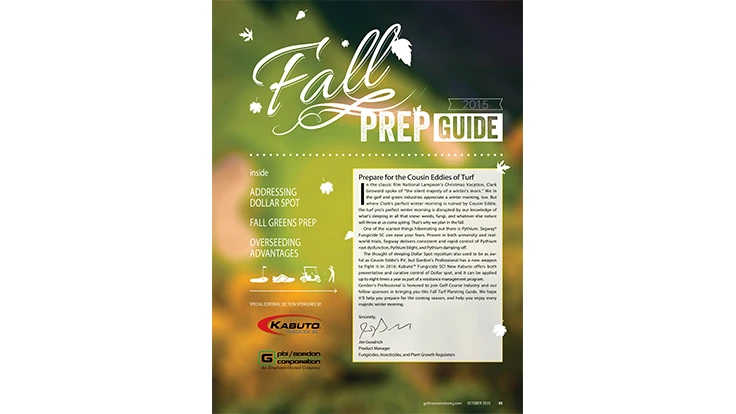
 Sometimes superintendents need to utilize some “special effects” to achieve a certain course esthetic. Their turf may be under stress due to warm, humid conditions, or it may be in protection mode due to evening or early morning chill. That’s where overseeding comes in. Call it the industry’s way of giving Mother Nature an assist.
Sometimes superintendents need to utilize some “special effects” to achieve a certain course esthetic. Their turf may be under stress due to warm, humid conditions, or it may be in protection mode due to evening or early morning chill. That’s where overseeding comes in. Call it the industry’s way of giving Mother Nature an assist.
Some superintendents, notably in the Transition Zone, overseed to bolster turf in the aftermath of a long, hot summer, says PBI-Gordon product manager Jim Goodrich, a former Kansas City superintendent.
“Overseeding is a consideration for guys in the Transition Zone and north after a rough summer,” he says. “We had a lot of moisture this year, but I talked with some of our distributor partners and they’re looking at a good overseeding year, just because of the fact that the turf didn’t really have a chance to dive down and search for water.
“Everything stayed so moist that the root systems were really shallow and then once it got hot and it was still wet all the turf cooked,” he adds. “[Golf courses] lost a lot of the roots; [the heat and humidity] boiled the roots and they lost a lot of turf in the rough areas. That’s the other side of the coin where you have to overseed those rough areas and maybe even some fairways if you have cool-season bluegrass to get it ready to go in the spring.”
Conditions vary at each facility, but Goodrich says Transition Zone superintendents often rely on rye or creeping bentgrass to overseed their fairways. Bluegrass is a popular choice for roughs, although an increasing number of clubs are utilizing tall fescue as an alternative. “It looks and plays like bluegrass,” he says. “It’s a little heartier, and it’s more heat tolerant.”
In warmer climates south of the Transition Zone, the decision to overseed is based largely on aesthetics, but is no less significant because its importance is measured in dollars. High-end resorts regard lush green turf as marketing tools, says PBI-Gordon manager of field research Jeff Marvin. “The resort golf courses are catering to snowbirds,” he says. “They want a nice green golf course so they tend to be the ones that overseed.”
To overseed or paint?
Not overseeding? Then the use of paint may well be a viable option. Paint adds color to a golf course and provides visitors with the green look they crave, even if Bermudagrass greens lose their color during the winter months. The reality is, if a course is green, golfer will come.
There are, however, other tangible benefits to painting, including:
- The cost of overseeding 18 (or more) greens is far greater than the cost of painting, perhaps twice as much or more. At a time when many superintendents are having to get creative to make their budgets work, those are dollars that can be utilized elsewhere.
- A coat or two of paint or pigment will increase the soil temperature. In effect, the paint forms a protective blanket over the turf beneath it. Research has shown that turf that was pained in the fall or winter came around more quickly in the spring.
- Golfers playing on painted turf will enjoy the ambiance of a green golf course and will also be taking advantage of a golf course that is playing firm and fast. Because the turf is not growing, the golfer will benefit from more roll and thus greater distance.
- It should be noted, however, that thin or dormant turf painted green is still thin or dormant turf, and all necessary precautions must be taken to protect it. That includes spreading out hole locations to minimize wear in any one particular area, including areas where players enter and exit the greens.
Typically, resort destinations can afford to overseed. “Overseeding looks great,” says Dr. Karl Danneberger, an associate professor at The Ohio State University. “I love playing golf on warm-season greens that have been overseeded, but it costs a lot of money. You’ve got to mow them, you’ve got to water them.”
Goodrich notes overseeding must be carefully scheduled, ideally for a period when nighttime soil temperatures drop into the 50s and Bermudagrass begins to lose its color. “You want to have a smooth transition so you’re not left with a period where you just have brown turf,” he says. “The timing is really critical. The Bermuda starts to go dormant and then you’re overseeding at the same time so your ryegrass is green or your Poa trivialis or whatever your turf of choice is to overseed.”
Marvin spent his time as a superintendent in central Florida, where overseeding generally begins around Oct. 1, later in the southern part of the state. He notes some superintendents will simply put their supply of seed into a large rotary-type spreader and spread it over the entire golf course. The process requires a lot of seed.
In its Central Region, which includes a large portion of the Midwest, the USGA Green Section recommends using 1.5 pounds of Kentucky bluegrass per 1,000 square feet, or as alternatives for the same coverage area, five pounds of ryegreass, five pounds of turf-type tall fescue, two pounds of fine fescue, or three-quarters of a pound of creeping bentgrass.
Every turf manager has his own preferences of course and Marvin was no exception when he was a superintendent. “If you’re overseeding a tee, a fairway, roughs, you’re going with ryegrass,” he says. “Typically what I would run on my course would be about 400 pounds (of ryegrass seed) to the acre (an acre encompasses 43,560 square feet).”
The amount of seed required varies from one region of the country to another. Facilities in the Carolinas or southern Virginia require less seed than a southern Florida course.
“The farther you go south, the higher that [amount of seed per acre] ratio is to be,” Marvin says. “You’re going to lose some of that newly seeded ryegrass to heat stress. I’ve heard people in Miami talk about overseeding courses in that area up to about 800 pounds an acre. You know you’re going to have some mortality just from the heat; the plant’s not going to make it.”
Marvin would always be sure to overseed the entire golf course (tees, roughs and fairways) and would be sure to order enough seed to have some left over for unwanted, but not totally unexpected occurrences. “You’re always going to have areas that may not establish well,” Marvin says, “or you may get a 2-inch rain the next day and wash away some of your seed. You always want to have an extra pound or two lying around so if that does happen you can go out and touch up certain areas.”
Soil temperatures also influence turf management practices. In portions of Florida, soil temperatures may not fall low enough for Bermudagrass to go completely dormant, although the loss of chlorophyll will cause the turf to lose color.
In parts of the Southwest it’s a different situation. Bermudagrass goes dormant for six to 10 weeks, roughly from mid-December until sometime in February depending on the temperatures in a given year.
The prime time to overseed is just prior to the beginning of the dormancy period with ryegrass being the seed of choice. During this time, the golf course will close to allow for efforts to limit the growth of the Bermudagrass and allow the ryegrass to germinate more effectively. This down time allows for application of additional water to accelerate the germination process.
The USGA has other recommendations for handling overseeding, including sowing the seed in two directions with a slit seeder, drop seeder or broadcast seeder, and dragging with a steel mat or chain. It also suggests watering more deeply than normal to strengthen the root system.
While a number of courses overseed, relatively few take this approach with their putting surfaces. “Some superintendents will go with a bentgrass or a bentgrass/Poa trivialis blend,” Marvin says. “What you hope for with the bentgrass in there is as it germinate it helps to fill in and around the Poa trivilalis. The Poa trivialis tends to be clumpier and doesn’t tend to spread as well as creeping bentgrass would. A superintendent might run something like an 80/20 or 70/30 Poa-bentgrass mix.”
It’s important not to let the seed overwhelm the existing Bermuda surface. “You need to be particularly careful on greens to not allow the overseeded grass to get too dense or too mature to where it crowds out the Bermudagrass,” Marvin says. “I typically started with a very light rate on greens when overseeding and would add additional throughout the year if I need a little extra color for certain areas. I would lightly groom the greens one or two times per week to keep the Poa trivialis leaf blades narrow.”

Explore the October 2015 Issue
Check out more from this issue and find your next story to read.
Latest from Golf Course Industry
- From the publisher’s pen: Conscientious of a bigger role
- Bernhard and Company partners with Laguna Golf Phuket
- Terre Blanche showcases environmental stewardship
- VIDEO: Introducing our December issue
- Bernhard and Company introduces Soil Scout
- Nu-Pipe donates to GCSAA Foundation’s Centennial Campaign
- GCSAA enhances golf course BMP tool
- Melrose leadership programs sending 18 to 2026 GCSAA Conference and Trade Show





